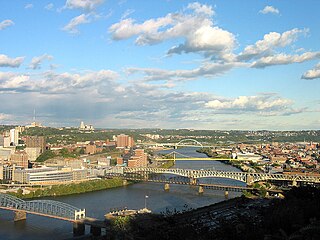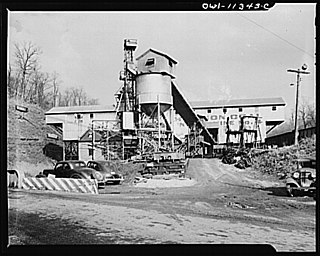
North Braddock is a borough in Allegheny County, Pennsylvania, United States, along the Monongahela River. The 2020 census had the borough population at 4,320. It is a suburb 11 miles (18 km) east of Pittsburgh. Organized from a part of Braddock Township in 1897, the borough prides itself in being the "Birthplace of Steel" as the home of Andrew Carnegie's Edgar Thomson Steel Works that opened in 1875.

West Homestead is a borough in Allegheny County, Pennsylvania, United States, 8 miles (13 km) southeast of Pittsburgh, on the Monongahela River. Heavy industries associated with nearby steel mills existed here, such as axle works, brickworks, and manufactories of machinery, car wheels, etc. The largest concern was Mesta Machinery, which was one of the world's leading industrial manufacturers from 1898 until 1983. The population was 1,872 at the 2020 census.

The Monongahela River, sometimes referred to locally as the Mon, is a 130-mile-long (210 km) river on the Allegheny Plateau in north-central West Virginia and Southwestern Pennsylvania. The river flows from the confluence of its west and east forks in north-central West Virginia northeasterly into southwestern Pennsylvania, then northerly to Pittsburgh and its confluence with the Allegheny River to form the Ohio River. The river includes a series of locks and dams that makes it navigable.

The Monongahela Railway was a coal-hauling Class II railroad in Pennsylvania and West Virginia in the United States. It was jointly controlled originally by the Pennsylvania Railroad, New York Central subsidiary Pittsburgh and Lake Erie Railroad, and the Baltimore and Ohio Railroad, with NYC and PRR later succeeded by Penn Central Transportation. The company operated its own line until it was merged into Conrail on May 1, 1993.
The Pittsburgh and Lake Erie Railroad, also known as the "Little Giant", was formed on May 11, 1875. Company headquarters were located in Pittsburgh, Pennsylvania. The line connected Pittsburgh in the east with Youngstown, Ohio, in the Haselton neighborhood in the west and Connellsville, Pennsylvania, to the east. It did not reach Lake Erie until the formation of Conrail in 1976. The P&LE was known as the "Little Giant" since the tonnage that it moved was out of proportion to its route mileage. While it operated around one tenth of one percent of the nation's railroad miles, it hauled around one percent of its tonnage. This was largely because the P&LE served the steel mills of the greater Pittsburgh area, which consumed and shipped vast amounts of materials. It was a specialized railroad, deriving much of its revenue from coal, coke, iron ore, limestone, and steel. The eventual closure of the steel mills led to the end of the P&LE as an independent line in 1992.

The Jones and Laughlin Steel Corporation, also known as J&L Steel or simply as J&L, was an American steel and iron manufacturer that operated from 1852 until 1968. The enterprise began as the American Iron Company, founded in 1852 by Bernard Lauth and Benjamin Franklin Jones, about 2.5 mi (4.0 km) south of Pittsburgh along the Monongahela River. Lauth's interest was bought in 1854 by James Laughlin. The first firm to bear the name of Jones and Laughlin was organized in 1861, and headquartered at Third & Ross in downtown Pittsburgh.

Hays is a neighborhood in the 31st Ward of the east side of Pittsburgh, Pennsylvania. It is represented on the Pittsburgh City Council by the representative of District 5. It occupies ZIP codes 15227, 15207, and 15236. It is named after James H. Hays, who opened a coal-mining operation called Hays and Haberman Mines in 1828.

Turtle Creek is a 21.1-mile-long (34.0 km) tributary of the Monongahela River that is located in Allegheny and Westmoreland counties in the U.S. state of Pennsylvania. Situated at its juncture with the Monongahela is Braddock, Pennsylvania, where the Battle of the Monongahela was fought in 1755.
Fort Laughlin was a Civil War redoubt, built in 1863 for the defense of Pittsburgh by the employees of Jones and Laughlin Iron Works, and named for James H. Laughlin. It was also known as Fort McKinley or Fort Ormsby. It was a circular earthwork on Ormsby's Hill, now part of Arlington Park on Arlington Avenue.

Becks Run Road is a street in the Pittsburgh metropolitan area. It connects Brownsville Road in the Carrick neighborhood of Pittsburgh with East Carson Street on the South Side. It is part of the Blue Belt road system. It is one of few roads connecting the low-lying areas along the Monongahela River with the higher elevations to the south, and is therefore heavily traveled, in spite of being steep and narrow in some sections.

James Harden Hays was a pioneer of bituminous coal mining in Western Pennsylvania.

Pittsburgh, Pennsylvania, was a thriving and important city during the American Civil War, and provided a significant source of personnel, war materiel, armament, ammunition, and supplies to the Union Army. Situated at the confluence of the Monongahela, Allegheny and Ohio rivers, Pittsburgh was an important transportation hub for both riverine and rail transport, as well as overland via its system of roads.
The Keeling Coal Company (1861–1878) was a 19th-century coal mining company in Allegheny County, Pennsylvania. Its mines were located in the Pittsburgh Coalfield of western Pennsylvania.
The Birmingham Coal Company was a coal mining company in the Pittsburgh Coalfield area. It operated mines along Becks Run, as well as other mines south of the Monongahela River, such as the Bausman Mine and the American Mine. It is named for Birmingham, Pennsylvania, a town which was later annexed to Pittsburgh. Part of the company was the Birmingham Coal Company Railroad, a 3 ft 2 in narrow gauge railroad that ran Along 21st street. Coal was transferred underground using a tailrope system from Spiketown to the mine entrance, and from there to the railroad on a gravity plane to the railroad.
Streets Run is a 5.2-mile-long (8.4 km) tributary of the Monongahela River in Allegheny County, Pennsylvania. This urban stream drains portions of the communities of Pittsburgh, Baldwin, Brentwood, West Mifflin and Whitehall, an area of about ten square miles.

The Pittsburgh Terminal Coal Company was a bituminous coal mining company based in Pittsburgh and controlled by the Mellon family. It operated mines in the Pittsburgh Coalfield, including mines in Becks Run and Horning, Pennsylvania. Unusually for that time in Pennsylvania, it hired African-American miners for some of its work.

The Pittsburgh and Castle Shannon Plane was a 3 ft 4 in narrow gauge incline railway that ran from the northern end of the Pittsburgh and Castle Shannon Tunnel to Carson Street in Pittsburgh, Pennsylvania.
The Monongahela River Consolidated Coal and Coke Company was a railroad and coal transportation company, founded in 1899 in Pittsburgh, Pennsylvania. It was formed by merging more than 80 independent coal mines and river transportation businesses, both in Pennsylvania and Kentucky. Initially, it had an agreement with the Pittsburgh Coal Company to ship its coal only by water, and not to compete with it by using rail transport, but the agreement was ended in 1902. It merged with the Pittsburgh Coal Company on 24 December 1915.
Broadford, or Broad Ford, is an unincorporated community in Connellsville Township, Fayette County, Pennsylvania, southeast of Pittsburgh in the United States. Broadford is on the Youghiogheny River downstream from Connellsville. Galley Run, a tributary to the Youghiogheny River, joins here.

Lick Run is a 6.7-mile-long (10.8 km) urban stream in southern Allegheny County, Pennsylvania, a tributary of Peters Creek. The former Lick Run coal mine of the Pittsburgh Coal Company had its mouth near the stream, along the B&O Railroad line.













